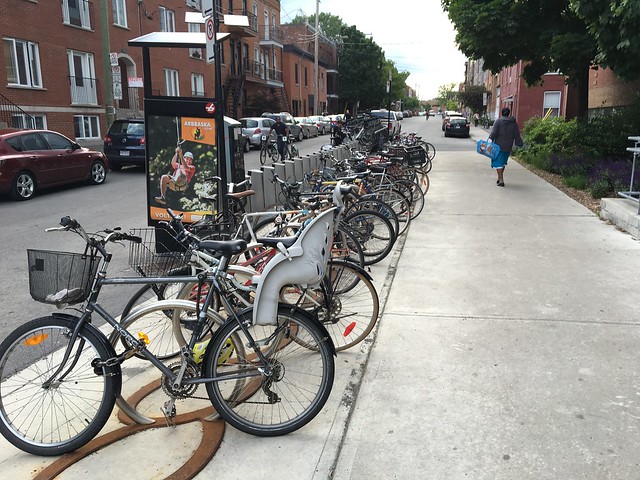For 30 years it’s been whispered about, a bicycle urban legend passed among envious cyclists throughout North America, every few years rearing its head with a little piece of news that brings hope, then despair. And now, it’s come up again here, in my city of Calgary.
It’s the Idaho stop law.
In reality, it’s hardly dramatic: a traffic statute that allows cyclists to yield at stop signs rather than coming to a full stop. But because it’s been talked about, teased and killed so many times, it’s become legendary in status.

I first wrote about this idea back in 2015, and I’ll paste that piece of writing below. But because the idea has been greeted here in Calgary with the same old reactions and arguments against it everywhere, I thought I’d spend a little time explaining it a in the video below. Enjoy.
This was originally published in the Calgary Herald on Oct. 16, 2016, under the headline: Is it time to let cyclists roll through stop signs?
Idaho, famous for potatoes and summering beach-deprived Calgarians, is in the news for something different: a 30-year-old traffic statute that is suddenly most-talked about new idea in urban transportation.
In the early 1980s, concerned that trivial traffic matters were cluttering the courts, a magistrate judge in Idaho changed the rules to allow cyclists to treat stop signs as yields. Rather than forcing people on bikes to come to a full stop at each red octagon, cyclists were allowed to slow and roll through them when safe.
For the next 30 years, Idahoans went yielding on their own merry way without drawing much attention, other than from cycling advocates elsewhere who looked on with envy. In the last few months, however, the “Idaho stop law” has suddenly become a talking point. Both Montreal and San Francisco are considering adopting similar rules, and a subsequent debate has ensued.
It’s easy to understand the appeal of this law to cyclists. Stop signs, to be frank, suck. They are hard work. Coming to a full stop and then pedalling back up to full acceleration is a huge expenditure of energy (this study, pointed out to me by Kay Teschke, found that regular stop signs require so much energy they can drop a cyclist’s speed by 40 per cent). This is especially galling on a bike when there’s good visibility and the stop sign is in an inconvenient location, such as the bottom of a hill, there’s no risk to rolling through, and the sign was clearly intended for motor vehicles. And, let’s face it, the risk posed by a bike in such a situation is much less than a car.
Yet adoption of the law has been pretty much non-existent outside of Idaho. As more cities look to make life easier for cyclists, however, the law is getting a second look. There is, however, some opposition, mostly from car drivers resentful of some perceived advantage being given to people on bikes. Everybody, they say, should obey the same rules.
With that in mind, I called Kurt Holzer to see how the law works in the real world of Idaho. Holzer lives in Boise, is a personal injury attorney who often represents cyclists, and he rides his bike a lot, so he knows of which he speaks. His assessment of the law was simple.
“In my 20 years, I’ve never see a case where the stop-as-yield law has caused a problem,” he told me. As a lawyer, he likes that it “eliminated a bunch of tickets and unnecessary confrontations with police.” As a cyclist, he loves the little boost that comes with rolling through stop signs when safe to do so.
He’s not the only one. For most Idahoans, the law has become a non-issue. In fact, Holzer says it works so well, he’s surprised it hasn’t been more widely adopted.
A study was done on the law in 2010. Researcher Jason Meggs at UC Berkeley found that bicycle injuries declined 14.5 per cent the year after the law was adopted. He also found Idaho cities fared 30.4 per cent better in bicycle safety than similar cities that lacked the law. “The law has been beneficial or had no negative effect,” he wrote. Another sign of the law’s efficacy is its rather low-key success in Idaho over 30 years.
Still, those arguments against the law persist. Holzer dismisses the standard oppositions to the law as “weak arguments.” As for the idea that cyclists would be given preferential treatment, Holzer points out that some road users already have different laws. Some jurisdictions, for example, require school buses to stop at railway crossings, or require big trucks to obey different speed limits than other vehicles. The same approach can apply to cyclists.
Others have argued against the law on the basis of protecting pedestrian rights, but Holzer also likes the law because it better reflects reality. Yes, that means the law acknowledges that some cyclists already roll through stop signs.
The key point in this debate is probably this: The law works in Idaho when people obey it. There are still altercations at intersections, and sometimes cyclists blow through stop signs without yielding, but they are breaking the law. Every problem situation Holzer has seen is because somebody disobeyed the statute. People on bikes are still required to stop for safety. The law is not an excuse to ride like a jerk.
“It’s a rational statute that acknowledges vehicle and human behaviour, and enhances, rather than dismisses, safety on the road,” he said. “And for (vehicle drivers), I can get out of your dang way faster and not pose an obstacle to you because it allows me to . . . clear the intersection more quickly.”
In the long run, however, the law remains appealing because it makes life just a little bit easier for law-abiding cyclists. With so many cities striving to do just that, it may be an Idahoan idea whose time has come.
Please subscribe to our YouTube channel.
Follow Tom Babin on Twitter, Facebook, Instagram or Medium.
You can also follow Shifter on Facebook or Medium.
Tom Babin is the author of Frostbike: The Joy, Pain and Numbness of Winter Cycling.



